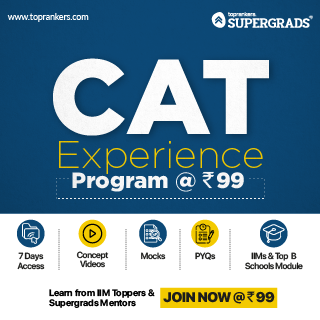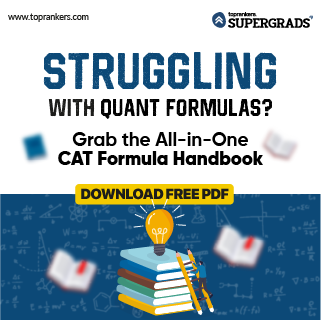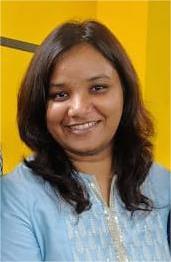CAT Arithmetic Syllabus 2026 PDF Download [Important Topics and Weightage]
November 24, 2025
Overview: Having a good practice of the CAT Arithmetic syllabus and important topics can help you crack the CAT exam 2026 with a high percentile. Read on to know the complete details about the CAT exam arithmetic syllabus!
The CAT QA section consists of 22 questions, of which the Arithmetic section holds about 8-10 questions.
The CAT arithmetic syllabus 2026 includes
- Profit & Loss,
- Time & Work,
- Ratios & Proportions,
- Averages, Time, Speed & Distance,
- Simple & Compound Interest
- Mixtures & Alligations, and Percentages.
Continue reading to know more about the CAT arithmetic syllabus 2026 with practice questions.
CAT Arithmetic Syllabus 2026: Major Highlights
CAT Arithmetic Syllabus holds significant weightage in the CAT 2026 syllabus, making it crucial to understand these concepts thoroughly. Typically, students can expect to see around 8-9 questions specifically from the Arithmetic section.
Key Topics (Syllabus 2026):
- Profit & Loss
- Time & Work
- Ratios & Proportions
- Averages
- Time, Speed & Distance
- Simple and Compound Interest (SI & CI)
- Mixtures & Alligations
- Percentages
Read more: CAT Exam Pattern 2026: Section-Wise Format, Duration & Marking Scheme
CAT Arithmetic Syllabus 2026: Important Topics to Practice Now
The Arithmetic CAT syllabus holds many marks. Let's explore each key topic within the CAT 2026 Arithmetic syllabus, complete with explanations and practical questions to solidify your understanding.
1. CAT Arithmetic Syllabus 2026: Topics for Percentages
Percentages are essential in quantitative aptitude, and understanding them can greatly improve your efficiency in various mathematical topics. Key areas to focus on include
Key Concepts:
- Calculating percentage increase/decrease.
- Successive percentages (e.g., discounts, growth).
- Percentage point changes vs. percentage changes.
- Applications in population, taxes, profit, etc.
Practice with: CAT Trigonometry Question with Solutions
CAT Percentage Practice Questions:
1. In a class of 80 students, 65% are boys. How many girls are there in the class?
- 24
- 28
- 32
- 20
Correct Answer: 28
2. The price of a bicycle was ₹6000 last year. This year, its price increased by 15%. What is the current price of the bicycle?
- ₹6750
- ₹6900
- ₹7200
- ₹7500
Correct Answer: B. ₹6900
Check: Number System CAT Questions
3. A shop offers two successive discounts: a 20% discount and a 10% discount on the reduced price. If the original price of an item is ₹1500, what is the final selling price after both discounts?
- ₹1050
- ₹1080
- ₹1125
- ₹1200
Correct Answer: ₹1080
CAT + OMETs Demo Classes
| Take DILR Demo Classes by Supergrads | |
| Take VARC Demo Classes by Supergrads | |
| Take QA Demo Classes by Supergrads |
2. CAT Arithmetic Syllabus 2026: Topics for Profit and Loss (P&L)
This section focuses on the financial aspects of buying and selling, incorporating discounts and understanding margins.
Key Concepts:
- Cost Price (CP), Selling Price (SP), Profit, Loss.
- Profit/Loss Percentage.
- Marked Price (MP) and Discount.
- Successive discounts.
- Dishonest dealer problems.
Explore: CAT Trigonometry Questions
CAT Profit & Loss Practice Questions:
1. A shopkeeper bought a table for ₹2500 and sold it for ₹3000. What is his profit percentage?
- 15%
- 20%
- 25%
- 30%
Correct Answer: 20%
2. By selling an article for ₹960, a person incurs a loss of 4%. What was the cost price of the article?
- ₹998.40
- ₹1000
- ₹1040
- ₹1080
Correct Answer: ₹1000
3. A dealer allows a discount of 25% on the marked price of an article and still makes a profit of 20%. If the cost price of the article is ₹1200, what is its marked price?
- ₹1600
- ₹1800
- ₹2000
- ₹2400
Correct Answer: ₹2000
3. CAT Arithmetic Syllabus 2026: Topics for Ratio and Proportion
Ratio and Proportion questions test your ability to compare quantities and divide them proportionally.
Key Concepts:
- Basic ratios, inverse ratios, compounded ratios.
- Direct and inverse proportion.
- Partnership problems.
- Problems involving ages based on ratios.
CAT Practice Questions
1. The ratio of two numbers is 5:7. If their sum is 144, what is the larger number?
- 60
- 72
- 84
- 96
Correct Answer: 84
CAT + OMETs Mock Test to Boost Your Prep
| Free CAT Mock Test -01 | |
| Free CAT Mock Test- 02 | |
| Free CAT Mock Test- 03 |
2. A, B, and C started a business by investing money in the ratio 3:4:5. At the end of the year, they earned a total profit of ₹18000. What is B's share of the profit?
- ₹4500
- ₹6000
- ₹7500
- ₹9000
Correct Answer: ₹6000
3. If A:B = 2:3 and B:C = 4:5, what is the ratio A:B:C?
- 6:8:15
- 8:12:15
- 2:7:5
- 8:12:10
Correct Answer: 8:12:15
4. CAT Arithmetic Syllabus 2026: Topics for Averages
Averages help represent a dataset with a single value, often involving weighted averages. It includes the key concepts like:
- Simple average formula.
- Weighted averages (crucial for Mixture & Alligation).
- Average speed.
- Problems involving additions or removals from groups.
CAT Practice Questions:
1. A student scored 70, 85, 90, and 75 marks in four subjects. What is his average score across these four subjects?
- 78.5
- 80
- 82.5
- 85
Correct Answer: 80
2. The average age of 15 students in a class is 12 years. If a new student joins, the average age of the class becomes 12.5 years. What is the age of the new student?
- 18 years
- 19 years
- 20 years
- 20.5 years
Correct Answer: 20 years
3. A car travels from city A to city B at a speed of 50 km/hr and returns from city B to city A at a speed of 30 km/hr. What is the average speed of the car for the entire journey?
- 35 km/hr
- 37.5 km/hr
- 40 km/hr
- 42.5 km/hr
Correct Answer: 37.5 km/hr
Use SuperGrads Free Resources 2026 Strategically
| CAT VARC Mock Test 2026 | |
| CAT DILR Mock test 2026 | |
| CAT QA Mock Test 2026 | |
| CAT VARC Prep Videos 2026 | |
| CAT DILR Prep Videos 2026 | |
| CAT QA Prep Videos 2026 | |
| CAT Syllabus 2026 | |
| CAT PYQs | |
| CAT VARC Questions |
5. CAT 2026 Arithmetic Syllabus for Time, Speed & Distance (TSD)
TSD problems involve calculating distance, speed, and time, often in situations involving relative motion.
The Key Concepts include:
- Distance = Speed × Time.
- Unit conversions (km/hr to m/s, etc.).
- Relative speed (same direction, opposite direction).
- Problems with trains, boats/and streams.
- Races and circular tracks.
CAT Practice Questions
1. A car travels at a speed of 60 km/hr. How much distance will it cover in 4 hours and 30 minutes?
- 240 km
- 270 km
- 300 km
- 330 km
Correct Answer: 270 km
2. A train 120 meters long is running at a speed of 54 km/hr. How long will it take to cross an electric pole?
- 6 seconds
- 8 seconds
- 10 seconds
- 12 seconds
Correct Answer: 8 seconds
3. Two cars start from opposite ends of a 400 km long road. Car A travels at 70 km/hr and Car B travels at 50 km/hr. In how much time will they meet if they start simultaneously?
- 2 hours
- 2.5 hours
- 3 hours
- 3.5 hours
Correct Answer: 3.5 hours
Check: Practice CAT Previous Year Question Papers with Answers
6. CAT 2026 Arithmetic Syllabus for Simple and Compound Interest (SI & CI)
These topics explore how money grows over time, distinguishing between fixed and compound interest.
The Key Concepts:
- Simple Interest (SI): I=(P×R×T)/100.
- Compound Interest (CI): A=P(1+R/100)T. CI=A−P.
- Difference between SI and CI.
- Half-yearly/quarterly compounding.
CAT Practice Questions
1. What is the simple interest on a principal amount of ₹8000 at an interest rate of 6% per annum for 5 years?
- ₹2000
- ₹2200
- ₹2400
- ₹2500
Correct Answer: ₹2400
2. Find the compound interest on ₹5000 for 2 years at an annual interest rate of 10%, compounded annually.
- ₹1000
- ₹1050
- ₹1100
- ₹1150
Correct Answer: ₹1050
3. The difference between the simple interest and compound interest on a certain sum of money for 2 years at an annual rate of 5% is ₹25. Find the sum.
- ₹5000
- ₹8000
- ₹10000
- ₹12000
Correct Answer: ₹10000
Read more: CAT Mensuration Questions with Solution
CAT 2026 Arithmetic Syllabus for Topics for Mixtures & Alligations
This topic, an extension of Ratios and Averages, deals with combining different quantities to achieve a desired concentration.
The Key Concepts include:
- Mixing liquids/ingredients in given ratios.
- Replacing portions of a mixture.
- The Alligation Rule (a powerful shortcut).
CAT Practice Questions:
1. In what ratio must a grocer mix two pulses costing ₹45/kg and ₹60/kg respectively, to get a mixture worth ₹50/kg?
- 1:2
- 2:1
- 3:2
- 2:3
Correct Answer: 2:1
2. A mixture contains milk and water in the ratio 4:1. If 10 litres of water are added to the mixture, the ratio of milk to water becomes 2:1. What was the original quantity of milk in the mixture?
- 20 litres
- 30 litres
- 40 litres
- 50 litres
Correct Answer: 40 litres
3. Two vessels contain milk and water. The first vessel has milk and water in the ratio 3:1, and the second vessel has them in the ratio 5:3. If the contents of both vessels are mixed in the ratio 1:1, what will be the ratio of milk to water in the final mixture?
- 8:3
- 11:5
- 13:7
- 15:8
Correct Answer: 13:7
8. CAT 2026 Arithmetic Syllabus for Time & Work
This topic deals with the rate at which tasks are completed by individuals or groups, often involving combined efforts or pipes and cisterns.
The Key Concepts are:
- Work rate (work done per unit time).
- Combined work of multiple individuals.
- Men, women, and children's problems (relative efficiency).
- Pipes and Cisterns (Filling and Emptying Rates).
CAT Practice Questions
1. A can do a piece of work in 10 days, and B can do the same work in 15 days. If they work together, in how many days will they complete the work?
- 5 days
- 6 days
- 7.5 days
- 8 days
Correct Answer: 6 days
2. Pipe A can fill a tank in 6 hours, and Pipe B can fill it in 8 hours. If both pipes are opened simultaneously, in how many hours will the tank be full?
- 3 hours 20 minutes
- 3 hours 26 minutes
- 3 hours 42 minutes
- 3 hours 50 minutes
Correct Answer: 3 hours 26 minutes
3. 12 men can complete a piece of work in 16 days. How many men would be required to complete the same work in 8 days?
- 18 men
- 20 men
- 24 men
- 32 men
Correct Answer: 24 men
Conclusion
Mastering the Arithmetic CAT syllabus exam is crucial for achieving a high score in the Quantitative Ability section. By focusing on key topics such as Percentages, Profit & Loss, Ratios & Proportions, and Averages, students can build a strong foundation to tackle various types of questions effectively.
Practising with a variety of questions not only enhances your understanding of these concepts but also boosts your confidence for the exam. As you prepare, remember to integrate these topics into your study routine and continuously assess your progress through practice problems.
With dedication and thorough preparation, you can elevate your performance and approach the CAT exam with assurance.
Frequently Asked Questions
What is the CAT Arithmetic syllabus?

How many questions from the Arithmetic section are there in the CAT exam?

Why is it important to practice Arithmetic for the CAT exam?

What types of questions can I expect in the Arithmetic section of the CAT?

How can I prepare effectively for the Arithmetic topics?
















SHARE